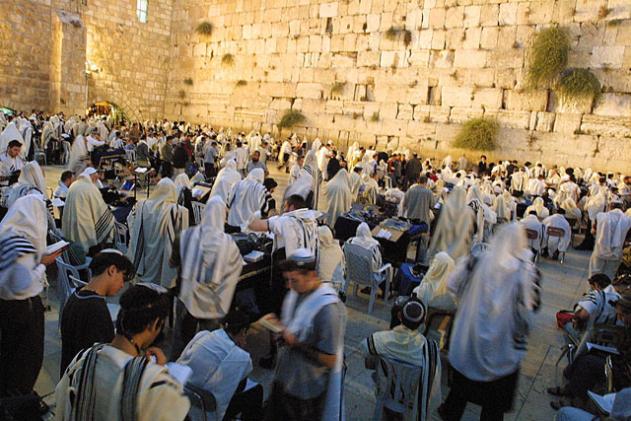 A Yom Kippur Guide for the Perplexed
A Yom Kippur Guide for the Perplexed
by Yoram Ettinger
 Yom Kippur painting circa 1900 by Isidor Kaufmann. Photo: Wikipedia
Yom Kippur painting circa 1900 by Isidor Kaufmann. Photo: Wikipedia
1. Yom Kippur is a day of hope and optimism, in addition to a solemn day of soul-searching. The Day of Atonement provides a unique awareness of one’s own character and track record, as well as the opportunity to upgrade relationships with relatives, friends, associates and the community at-large.
2. Yom Kippur’s focus on forgiveness highlights humility, fallibility, soul-searching faith, compassion, thoughtfulness, being considerate, accepting responsibility and magnanimity.
3. The first human being, Adam, was created on the first day of the Hebrew month of Tishrei. Human-beings are accorded an opportunity to recreate themselves spiritually, each year, on Yom Kippur — the 10th day of Tishrei, which is an Acadian word for forgiveness and Genesis.
Yom Kippur culminates 10 days of genuine, heart-driven atonement and repentance, which begin on Rosh Hashanah. Ten has special significance in Judaism: God’s abbreviation is the 10th Hebrew letter (Yod – י); there are 10 attributes of God — Divine perfection — that were highlighted during the Creation; the Ten Commandments; the Ten Plagues; there are 10 reasons for blowing the Shofar; individuals are commanded to extend a 10 percent gift to God (tithe); Ten Martyrs (Jewish leaders) were tortured/murdered by the Roman Empire; there were 10 generations between Adam and Noah and between Noah and Abraham; a 10-person-quorum (minyan in Hebrew) is required for a collective Jewish prayer; etc.
4. Yom Kippur is observed on the 10th day of the Jewish month of Tishrei, whose astrological sign is Libra. Libra symbolizes key themes of Yom Kippur: scales, justice, balance, truth, symmetry, sensitivity and optimism. Libra is ruled by the planet Venus (Noga, נגה, in Hebrew), which reflects divine light and love of other people.
5. Yom Kippur is a day of forgiveness for sins committed against God. It is customary to dedicate the eve of Yom Kippur to apologies for sins committed against fellow human-beings. However, apology and/or compensation are not sufficient if they do not elicit expressed forgiveness by the injured person.
6. Yom Kippur commemorates God’s covenant with the Jewish people, and God’s forgiveness for the sin of the Golden Calf.
7. Yom Kippur and the Jubilee both highlight liberty and subordination to God. The Jubilee — sanctifying each 50th year by proclaiming liberty, as inscribed on the Liberty Bell — is announced by blowing the shofar (a ritual ram’s horn) on Yom Kippur. The Jubilee liberates people physically and spiritually. The word “jubilee” (יובל) is a Hebrew synonym for shofar.
8. The Hebrew word Kippur, כיפור (atonement/repentance), is a derivative of the Biblical word Kaporet כפורת (the cover of the Holy Ark in the Sanctuary), and Kopher, כופר (the cover of Noah’s Ark and the Holy Altar in the Temple). Yom Kippur resembles a spiritual cover (dome), which separates the holy and the mundane, and spiritualism and materialism. The Kippah, כיפה (skullcap), which covers one’s head during prayers, reflects a spiritual dome.
9. Yom Kippur calls for repentance — Teshuvah (תשובה in Hebrew). The root of Teshuvah is similar to the root of the Hebrew word for return, שובה, and שביתה, the cessation of mundane thoughts, actions and eating. It is also similar to the root of Shabbat, שבת. Yom Kippur is also called Shabbat Shabbaton — the supreme Sabbath.
10. The Hebrew spelling of “fast” (צם/צום) reflects the substance of Yom Kippur. It is also the root of the Hebrew word for “reduction” and “shrinking” (צמצום) of one’s wrong-doing, and the root of the Hebrew words for “slave” (צמית) and “eternity” (צמיתות).

Zawartość publikowanych artykułów i materiałów nie reprezentuje poglądów ani opinii Reunion’68,
ani też webmastera Blogu Reunion’68, chyba ze jest to wyraźnie zaznaczone.
Twoje uwagi, linki, własne artykuły lub wiadomości prześlij na adres:
webmaster@reunion68.com


